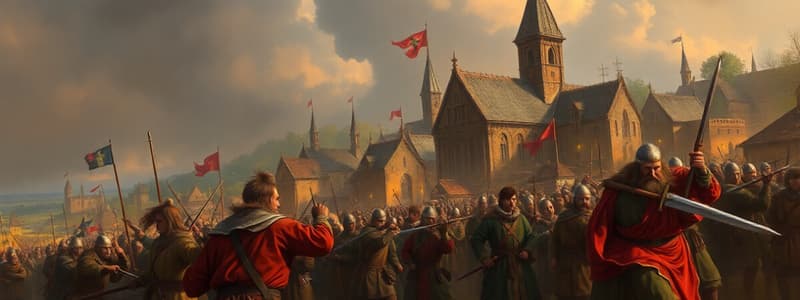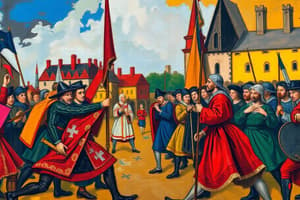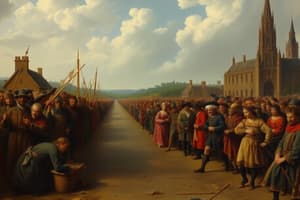Podcast
Questions and Answers
What significant religious outcome resulted from the Treaty of Westphalia?
What significant religious outcome resulted from the Treaty of Westphalia?
- It recognized Calvinism alongside Catholicism and Lutheranism. (correct)
- It established a one-state religion across Europe.
- It mandated the return of Catholic territories from Protestants.
- It prohibited any form of religious diversity in states.
Which battle is considered a turning point for the Protestant forces during the Thirty Years' War?
Which battle is considered a turning point for the Protestant forces during the Thirty Years' War?
- Battle of Breitenfeld (correct)
- Battle of Rocroi
- Battle of Nordlingen
- Battle of White Mountain
What was a key political impact of the Thirty Years' War on Europe?
What was a key political impact of the Thirty Years' War on Europe?
- The division of Europe into strictly Catholic and Protestant states.
- The rise of France as a major power in Europe. (correct)
- The strengthening of the Spanish monarchy.
- The establishment of a centralized Habsburg Empire.
What was one of the main causes of the Thirty Years' War?
What was one of the main causes of the Thirty Years' War?
Who was the pivotal figure for Protestant efforts during the Thirty Years' War?
Who was the pivotal figure for Protestant efforts during the Thirty Years' War?
Which battle led to a significant Catholic victory reversing Protestant gains in southern Germany?
Which battle led to a significant Catholic victory reversing Protestant gains in southern Germany?
What principle did the Treaty of Westphalia establish regarding state sovereignty?
What principle did the Treaty of Westphalia establish regarding state sovereignty?
Which major figure was instrumental in shaping France's involvement in the Thirty Years' War?
Which major figure was instrumental in shaping France's involvement in the Thirty Years' War?
How did the Thirty Years' War economically impact many regions in Europe, particularly Germany?
How did the Thirty Years' War economically impact many regions in Europe, particularly Germany?
What event marked the conclusion of both the Thirty Years' War and the Eighty Years' War?
What event marked the conclusion of both the Thirty Years' War and the Eighty Years' War?
Flashcards are hidden until you start studying
Study Notes
The Thirty Years' War
Causes of the War
- Religious Conflict: Tensions between Catholics and Protestants, especially in the Holy Roman Empire.
- Political Power Struggles: Rivalries among European powers, including France, Spain, and the Habsburgs.
- Dynastic Ambitions: Various rulers seeking to expand their territories and influence.
- Breach of Peace: The Peace of Augsburg (1555) failed to resolve underlying religious issues, leading to renewed hostilities.
Major Battles
- Battle of White Mountain (1620):
- Early Catholic victory in Bohemia.
- Battle of Breitenfeld (1631):
- Protestant forces under Gustavus Adolphus triumphed, marking a turning point.
- Battle of Lützen (1632):
- Gustavus Adolphus killed, but the Protestants maintained momentum.
- Battle of Nordlingen (1634):
- Significant Catholic victory, reversing Protestant gains in southern Germany.
- Battle of Rocroi (1643):
- French forces defeat the Spanish, indicating the decline of Spanish power.
Key Figures
- Ferdinand II: Holy Roman Emperor, key figure in the Catholic cause.
- Gustavus Adolphus: King of Sweden, pivotal in advancing Protestant efforts.
- Cardinal Richelieu: French chief minister, shaped France's involvement to weaken Habsburg power.
- Albrecht von Wallenstein: Notable general for the Imperial forces, influential in military strategy.
Impact on Europe
- Political Landscape: Shift in power dynamics; rise of France as a major power.
- Religious Tolerance: Established a precedent for coexistence between Catholics and Protestants.
- Territorial Changes: Redistribution of territories; strengthened some states while weakening others.
- Economic Devastation: Many regions, especially in Germany, faced severe destruction and population loss.
Treaty of Westphalia
- Date: Signed in 1648.
- Main Outcomes:
- Ended the Thirty Years' War and the Eighty Years' War.
- Recognized the sovereignty of over 300 German states.
- Affirmed Calvinism alongside Catholicism and Lutheranism as permissible faiths.
- Established principles of non-interference in the domestic affairs of other states, laying groundwork for modern international relations.
Causes of the War
- Religious tensions primarily between Catholics and Protestants, particularly in the Holy Roman Empire.
- Power struggles among European nations, notably between France, Spain, and the Habsburgs.
- Rulers pursued dynastic ambitions to expand territories and influence.
- Peace of Augsburg (1555) failed to address persistent religious conflicts, setting the stage for war.
Major Battles
- Battle of White Mountain (1620): Early victory for Catholic forces in Bohemia, bolstering Catholic control.
- Battle of Breitenfeld (1631): A significant turning point with a Protestant victory led by Gustavus Adolphus.
- Battle of Lützen (1632): While Gustavus Adolphus was killed, Protestant forces continued to gain momentum.
- Battle of Nordlingen (1634): Major Catholic victory, reversing Protestant advancements in southern Germany.
- Battle of Rocroi (1643): French forces defeated the Spanish, signaling a decline in Spanish hegemony.
Key Figures
- Ferdinand II: Holy Roman Emperor who played a crucial role in advancing the Catholic cause.
- Gustavus Adolphus: King of Sweden, instrumental in bolstering Protestant military efforts.
- Cardinal Richelieu: French chief minister who catalyzed France's involvement to diminish Habsburg dominance.
- Albrecht von Wallenstein: Key Imperial general known for his strategic military leadership.
Impact on Europe
- Political landscape altered with France emerging as a dominant power in Europe.
- Laid the groundwork for religious tolerance, creating potential for coexistence between Catholic and Protestant faiths.
- Resulted in substantial territorial redistribution, strengthening certain states while weakening others.
- Significant economic destruction, especially in Germany, leading to population losses and devastation.
Treaty of Westphalia
- Signed in 1648, it marked the official end of the Thirty Years' War and the Eighty Years' War.
- Recognized the sovereignty of over 300 German states, reshaping political boundaries.
- Affirmed Calvinism, alongside Catholicism and Lutheranism, as authorized religions.
- Established principles of non-interference in other states' domestic affairs, influencing modern international relations.
Studying That Suits You
Use AI to generate personalized quizzes and flashcards to suit your learning preferences.




